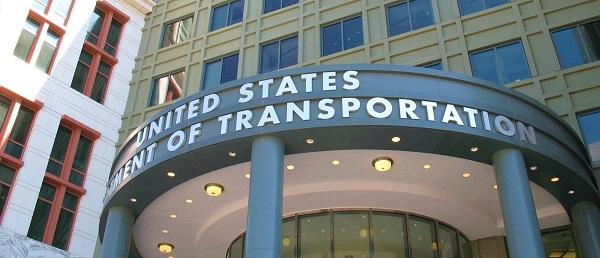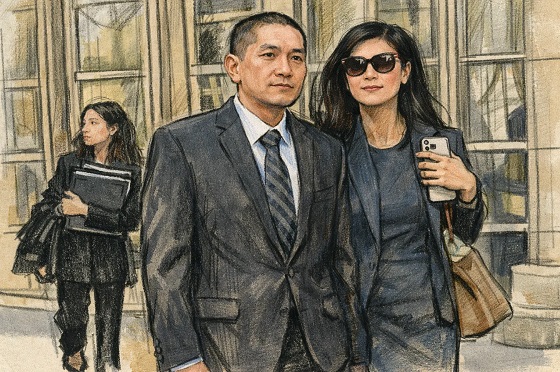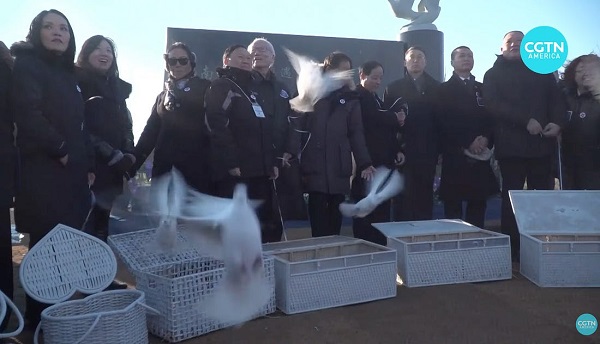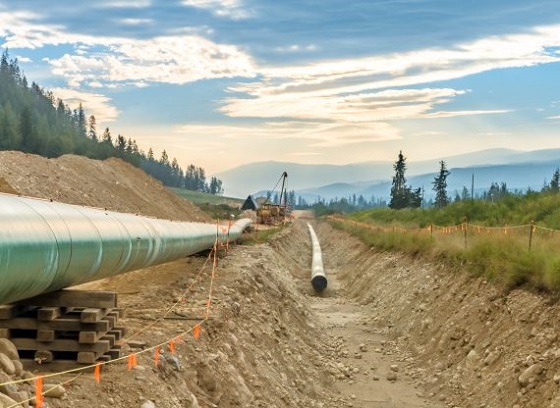Uncategorized
Defiant vigil starts healing in New Zealand after massacre

CHRISTCHURCH, New Zealand — They came together as one, more than 1,000 students from rival Christchurch schools and different religions, joining voices to
In a park across from the Al Noor mosque, where dozens were killed by a white supremacist gunman, the students sat on the grass in Monday’s fading daylight, lifting flickering candles to the sky as they sang a traditional Maori song.
Hundreds then stood to perform a passionate, defiant haka, the famed ceremonial dance of the indigenous Maori people.
For many, joining the vigil for the victims of the mass shooting was a much-needed opportunity to soothe their minds after a wrenching few days.
Most of the students spent hours locked down in their schools on Friday as police tried to determine if any other shooters were involved in the attacks.
Those at the vigil told harrowing tales of being forced to hide under classroom tables or on a school stage behind a curtain, of being instructed not to speak, and to urinate in a bucket rather than risk leaving the classroom for a bathroom.
Sarah Liddell, 17, said many of her peers felt intense anxiety since the attack. There was a sense of safety in coming together on Monday, she said.
“I feel like it’s just really important to show everyone that one act of violence doesn’t define a whole city,” she said. “This is one of the best ways to show everyone coming together. Some schools have little funny rivalries, but in times like this we all just come together and that’s all forgotten.”
The students draped a fence along the park with chains of colorful paper notes, each emblazoned with messages of love and hope and sorrow: “You are not alone.” ”This is your home. You are part of us.” ”We all bleed the same colour.”
For 17-year-old Portia Raharaha, who attended the vigil with other students from her Catholic high school, watching the haka was particularly moving.
“All the races combining, all students, all ages, both genders, we’re all just coming together,” Raharaha said. “It definitely makes you feel like New Zealand really does come together in a time of darkness and we can really just be who we are,” she said. “Nothing has really changed. Maybe it’s shaken us, but it really hasn’t changed us.”
After the ceremony officially ended, many lingered, standing in circles, arms draped around each other’s shoulders, singing Leonard Cohen’s “Hallelujah” and Maori songs. People wandered around with “free hugs” signs, embracing those in need. There were tears, but also smiles.
The students’ vigil was a striking and healing counterpoint to Monday’s developments in the mass shooting.
A Christchurch gun shop acknowledged selling guns online to the 28-year-old white supremacist accused of killing 50 people in shootings at two mosques that have upturned New Zealand’s reputation as one of the world’s most tolerant and safe nations.
At a news conference, Gun City owner David Tipple said the store sold four guns and ammunition to Brenton Harrison Tarrant through a “police-verified online mail order process.” The store “detected nothing extraordinary” about the buyer, he said.
Separately, Prime Minister Jacinda Ardern said gun law reforms would be announced within 10 days and an inquiry conducted into intelligence and security services that failed to detect the risk from the attacker or his plans. There have been concerns intelligence agencies were overly focused on the Muslim community in detecting and preventing security risks.
Police Commissioner Mike Bush said police are certain that Tarrant was the only gunman but aren’t ruling out that he had support.
“I would like tostate that we believe absolutelythere was only one attackerresponsible for this,” he said at a news conference. “That doesn’tmean there weren’t possibly otherpeople in support and that continuesto form a very, very important partof our investigation.”
None of the guns sold to Tarrant were military-style, semi-automatic weapons, according to Tipple. It was not clear if any of the firearms Tarrant purchased from Gun City were used in the shootings.
In vowing to tighten gun laws, Ardern has said the attacker used five guns, two of them semi-automatic, which were purchased with an ordinary gun license and modified.
Tipple said he was disgusted by the killings but felt no responsibility for the tragedy and refused to say whether he believed gun ownership laws should change in New Zealand, insisting that a debate over guns should be held at another time.
His store has been criticized, in the wake of the shootings, for leaving out a roadside advertising billboard that shows a parent helping children with rifle target practice.
Tarrant, an Australian citizen who lived in New Zealand, appeared Saturday in court, where the judge read one murder charge and said more would likely follow.
Tarrant had posted a muddled, 74-page anti-immigrant manifesto online before the attacks and apparently used a helmet-mounted camera to stream live video of the slaughter.
Relatives of the dead are now anxiously awaiting word on when they can bury their loved ones. Islamic tradition calls for bodies to be cleansed and buried as soon as possible after death, usually within 24 hours.
Ardern has said authorities hope to release all the bodies by Wednesday and police said authorities are working with pathologists and coroners to complete the task as soon as they can.
Members of the Muslim community and police were at a cemetery that has been fenced off and obscured with white netting. Backhoes had stopped digging and police officers said they were setting up a media area inside the cemetery.
Kawthar Abulaban, 54, who survived the shooting at the Al Noor mosque, came to the cemetery to see the preparations. She did not mind the row of photographers and reporters lined up outside.
“It’s good for the world to see what’s happened because people around the world, they thought we were terrorists because some stupid people, they said they are Muslims, they go and kill innocent people,” said Abulaban, who migrated to New Zealand from Jordan 17 years ago.
“I will not change my opinion about New Zealand. It’s my country,” she said. “You know I have lots of support, lots of love, lots of kindness from all of the New Zealand people.”
___
Associated Press writer Nick Perry contributed.
Kristen Gelineau, Juliet Williams And Stephen Wright, The Associated Press
Uncategorized
Cost of bureaucracy balloons 80 per cent in 10 years: Public Accounts

The cost of the bureaucracy increased by $6 billion last year, according to newly released numbers in Public Accounts disclosures. The Canadian Taxpayers Federation is calling on Prime Minister Mark Carney to immediately shrink the bureaucracy.
“The Public Accounts show the cost of the federal bureaucracy is out of control,” said Franco Terrazzano, CTF Federal Director. “Tinkering around the edges won’t cut it, Carney needs to take urgent action to shrink the bloated federal bureaucracy.”
The federal bureaucracy cost taxpayers $71.4 billion in 2024-25, according to the Public Accounts. The cost of the federal bureaucracy increased by $6 billion, or more than nine per cent, over the last year.
The federal bureaucracy cost taxpayers $39.6 billion in 2015-16, according to the Public Accounts. That means the cost of the federal bureaucracy increased 80 per cent over the last 10 years. The government added 99,000 extra bureaucrats between 2015-16 and 2024-25.
Half of Canadians say federal services have gotten worse since 2016, despite the massive increase in the federal bureaucracy, according to a Leger poll.
Not only has the size of the bureaucracy increased, the cost of consultants, contractors and outsourcing has increased as well. The government spent $23.1 billion on “professional and special services” last year, according to the Public Accounts. That’s an 11 per cent increase over the previous year. The government’s spending on professional and special services more than doubled since 2015-16.
“Taxpayers should not be paying way more for in-house government bureaucrats and way more for outside help,” Terrazzano said. “Mere promises to find minor savings in the federal bureaucracy won’t fix Canada’s finances.
“Taxpayers need Carney to take urgent action and significantly cut the number of bureaucrats now.”
Table: Cost of bureaucracy and professional and special services, Public Accounts
| Year | Bureaucracy | Professional and special services |
|
$71,369,677,000 |
$23,145,218,000 |
|
|
$65,326,643,000 |
$20,771,477,000 |
|
|
$56,467,851,000 |
$18,591,373,000 |
|
|
$60,676,243,000 |
$17,511,078,000 |
|
|
$52,984,272,000 |
$14,720,455,000 |
|
|
$46,349,166,000 |
$13,334,341,000 |
|
|
$46,131,628,000 |
$12,940,395,000 |
|
|
$45,262,821,000 |
$12,950,619,000 |
|
|
$38,909,594,000 |
$11,910,257,000 |
|
|
$39,616,656,000 |
$11,082,974,000 |
Uncategorized
Trump Admin Establishing Council To Make Buildings Beautiful Again


From the Daily Caller News Foundation
By Jason Hopkins
The Trump administration is creating a first-of-its-kind task force aimed at ushering in a new “Golden Age” of beautiful infrastructure across the U.S.
The Department of Transportation (DOT) will announce the establishment of the Beautifying Transportation Infrastructure Council (BTIC) on Thursday, the Daily Caller News Foundation exclusively learned. The BTIC seeks to advise Transportation Secretary Sean Duffy on design and policy ideas for key infrastructure projects, including highways, bridges and transit hubs.
“What happened to our country’s proud tradition of building great, big, beautiful things?” Duffy said in a statement shared with the DCNF. “It’s time the design for America’s latest infrastructure projects reflects our nation’s strength, pride, and promise.”
“We’re engaging the best and brightest minds in architectural design and engineering to make beautiful structures that move you and bring about a new Golden Age of Transportation,” Duffy continued.
Mini scoop – here is the DOT’s rollout of its Beautifying Transportation Infrastructure Council, which will be tasked with making our buildings beautiful again. pic.twitter.com/
9iV2xSxdJM — Jason Hopkins (@jasonhopkinsdc) October 23, 2025
The DOT is encouraging nominations of the country’s best architects, urban planners, artists and others to serve on the council, according to the department. While ensuring that efficiency and safety remain a top priority, the BTIC will provide guidance on projects that “enhance” public areas and develop aesthetic performance metrics.
The new council aligns with an executive order signed by President Donald Trump in August 2025 regarding infrastructure. The “Making Federal Architecture Beautiful Again” order calls for federal public buildings in the country to “respect regional architectural heritage” and aims to prevent federal construction projects from using modernist and brutalist architecture styles, instead returning to a classical style.
“The Founders, in line with great societies before them, attached great importance to Federal civic architecture,” Trump’s order stated. “They wanted America’s public buildings to inspire the American people and encourage civic virtue.”
“President George Washington and Secretary of State Thomas Jefferson consciously modeled the most important buildings in Washington, D.C., on the classical architecture of ancient Athens and Rome,” the order continued. “Because of their proven ability to meet these requirements, classical and traditional architecture are preferred modes of architectural design.”
The DOT invested millions in major infrastructure projects since Trump’s return to the White House. Duffy announced in August a $43 million transformation initiative of the New York Penn Station in New York City and in September unveiledmajor progress in the rehabilitation and modernization of Washington Union Station in Washington, D.C.
The BTIC will comprise up to 11 members who will serve two-year terms, with the chance to be reappointed, according to the DOT. The task force will meet biannually. The deadline for nominations will end Nov. 21.
-

 Business2 days ago
Business2 days agoGeopolitics no longer drives oil prices the way it used to
-

 Business2 days ago
Business2 days agoArgentina’s Milei delivers results free-market critics said wouldn’t work
-

 Business2 days ago
Business2 days agoDeadlocked Jury Zeroes In on Alleged US$40 Million PPE Fraud in Linda Sun PRC Influence Case
-

 International1 day ago
International1 day agoOttawa is still dodging the China interference threat
-

 Business1 day ago
Business1 day agoTaxing food is like slapping a surcharge on hunger. It needs to end
-

 COVID-191 day ago
COVID-191 day agoJudge denies Canadian gov’t request to take away Freedom Convoy leader’s truck
-

 espionage1 day ago
espionage1 day agoCarney Floor Crossing Raises Counterintelligence Questions aimed at China, Former Senior Mountie Argues
-

 Energy1 day ago
Energy1 day ago75 per cent of Canadians support the construction of new pipelines to the East Coast and British Columbia










